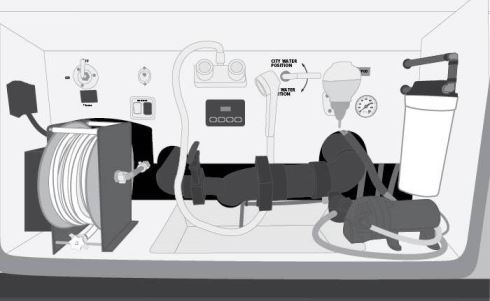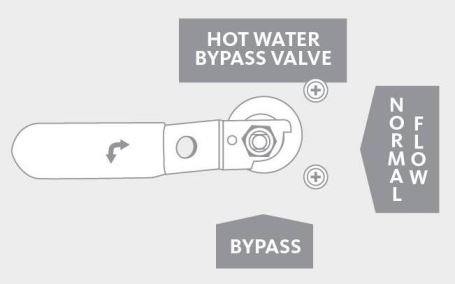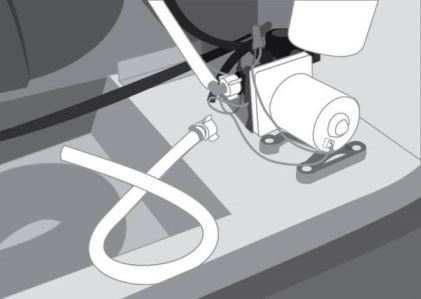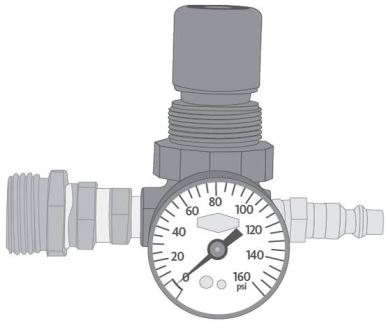Prepare your motorhome for the impending chill by following these recommendations.
By Mark Quasius, F333630
November 2013
Download PDF version of this article
For those who live in colder climates and can’t pack up and head south when the daylight hours grow shorter, winterizing the motorhome is a bothersome but necessary task. The job itself is not difficult; it’s the realization that you are putting away your pride and joy until spring. Yet, it has to be done or when spring arrives, you’ll be repairing all sorts of water leaks from freeze damage. Winter weather is unpredictable. Even Floridians can experience an occasional bout of freezing temperatures. If it’s a fluke weather event, you simply keep the heat on in the motorhome for a few days. For those who live in the northern climates, that’s not an option.
The main part of winterizing the motorhome involves removing all water from the plumbing system so it will not freeze, expand, and damage the water lines or components. Secondary tasks are to remove any personal items, such as cleaners or toiletries, that could freeze. Also, any food products that might attract pests should be removed. Finally, a good lubrication of the major moving parts is in order.
Air Versus Antifreeze
Two methods are used to winterize a motorhome’s plumbing system. One is to use air pressure to blow the water out of the lines. The second is to use RV antifreeze to force the water out of the lines. Air is easy to use. It’s free and it’s not messy. Air isn’t bad for a quick blowout during a brief bout of cold weather, but if your coach is stored in the far north where it stays cold for a long time, antifreeze is a better choice. When your motorhome’s fresh water system is blown out with air, some of the water may be bypassed, leaving a small amount that can settle into a low spot in the line, freeze, and cause damage. Living in Wisconsin, I’ve seen many examples of this, which is why dealers in this area prefer to use RV antifreeze. Even if you do use air to blow out the water system, you’ll still need to pour antifreeze into the traps to keep them from freezing and to prevent any holding tank odors from emanating into the coach.
RV antifreeze is not the same as the antifreeze you use in the cooling system for your motorhome’s engine. RV antifreeze is a pink nontoxic liquid that is safe to use in a plumbing system. When this solution freezes, it is designed to turn to slush, and unlike plain water, it won’t harden, expand, and damage the plumbing system. Pumping antifreeze into the fresh-water system will push through any water in the lines, rather than bypassing it. This ensures that none of the water settles into low spots. Any water that does remain will mix with the antifreeze and will not freeze and crack the lines or fittings.
One downside to winterizing the motorhome with antifreeze is that it can leave a bitter taste in the plastic lines. When it’s time to dewinterize the motorhome, you may need to flush the water system with fresh water several times to remove the antifreeze residue from the lines. One way to minimize that is to use a hybrid method of air and antifreeze. Blow out the lines with air first and then pump antifreeze through the system. Once the system is fully charged, use compressed air to blow the antifreeze out so that it’s easier to flush the lines when it’s time to dewinterize the coach. A small amount of antifreeze will remain in the system, but it will settle and won’t hurt anything.
 Initial Steps
Initial Steps
The first task is to drain and flush the holding tanks. Open the drain valve on the fresh-water tank and allow it to empty. Next, drain the black-water tank. This is a good time to use a flushing attachment to give the tank a thorough cleaning so as to prevent any residue from hardening and to minimize odors. Finally, drain the gray water tank. It may be helpful to use a clear plastic sewer hose adapter so you can see when the water coming from the tanks is clear.
Servicing The Water Heater
Before blowing out the lines, you need to turn your attention to the water heater. Water heaters in most motorhomes hold between 6 and 10 gallons of water. If your water heater has a 120-volt-AC heating element, begin by going to your circuit breaker box and switching off the circuit that supplies power to the water heater. That way, if anyone inadvertently turns on the electric heat for the water heater, the element won’t burn out.
The next step is to service the water heater. Begin by making sure there is no pressure in the water system, and then remove the water heater’s drain plug. If you have an Atwood water heater (aluminum tank), it will have a nylon drain plug. If you have a Suburban water heater (steel tank), it will have a steel plug with an anode rod attached.
![]() The anode rod is a sacrificial element that is designed to erode away when in contact with lime and other corrosive minerals in order to prevent damage to the steel tank. It’s a good idea to replace the anode annually. They aren’t expensive and you’re going to remove it to drain the heater tank anyway, so now is a good time to install a new one.
The anode rod is a sacrificial element that is designed to erode away when in contact with lime and other corrosive minerals in order to prevent damage to the steel tank. It’s a good idea to replace the anode annually. They aren’t expensive and you’re going to remove it to drain the heater tank anyway, so now is a good time to install a new one.
Once the drain plug has been removed, open the pressure relief valve to allow air to enter the tank to expedite draining. After the tank is drained, leave the plug out.
Your water heater should be equipped with a bypass valve that allows the incoming water to circumvent the tank. It may be a simple three-way valve or it may be a combination of ball valves. Be sure to check the owners manual for the exact location and type of valve. Set this bypass valve so that any water, air, or antifreeze passing through the system will not enter the water heater.
Water Filters And Drains
Before blowing out the system, remove any water filters you may have attached to the lines running to your faucets. If you have a canister-type filter, remove the element and discard it, then reinstall the empty canister. If you have an in-line filter, remove it and insert the supplied bypass hose. If the in-line filter does not have a way to bypass it, leave it in place for now, because you need to be able to pass air through that line. Be sure to install new water filters when you dewinterize the motorhome.
Near the bottom of the motorhome you’ll find a pair of low-point drain valves, one for the cold water lines and one for the hot water lines. In theory, you should be able to open these valves and all the water should drain out of the system. But in reality, the plumbing system is more complex, so that won’t happen. However, you can use air pressure to help the process along.
 Initial Blowout
Initial Blowout
Begin by attaching an air fitting to your garden hose and connect it to the fresh-water system. Make sure to use a filtered or dry air supply, since you don’t want to introduce any type of petroleum to the potable water. If your motorhome has an onboard air system with a dryer, you can use this air with a pressure reducer. Use a pressure regulator to keep the air pressure between 20 and 30 psi.
Blowout adapters can be found at any RV dealer or camping store, but most are inexpensive plastic items that require you to hold a tire chuck onto the fitting. This works, but it can become tiring after awhile, and you can’t leave the air connected while you move around inside the motorhome unless you have a second person assisting. Instead, go to a local home improvement store and purchase a small air pressure regulator with a gauge and a brass fitting that converts pipe thread to garden hose thread. Insert a quick-disconnect fitting that fits your air hose, and you’ll have a good hands-free regulator that will make the job much easier to perform.
With the water heater bypass valve set to the bypass position, open each faucet in the motorhome one at a time to blow any water out of each line. Do this for both the cold and hot water faucets until all of the water is gone and only air exits each fixture. Don’t forget to include any outside shower faucet that may be in your utility bay. Finally, open the low-point valves and blow them out until only air comes out.
 Antifreeze
Antifreeze
After the system has been blown out, it’s time to introduce the RV antifreeze into the system. Some motorhomes may be equipped with a winterizing valve and a siphon hose. If that’s the case, simply drop the hose into a container of RV antifreeze and turn the valve so that your water pump draws from the siphon hose rather than the fresh-water tank.
Other motorhomes may be equipped with a detachable pickup hose that connects to the water pump. In that situation, remove the inlet hose from the water pump strainer and attach the short pickup hose in its place. Drop the hose into a container of RV antifreeze and begin pumping. It may be helpful to have a large, clean bucket that you can fill with the antifreeze, which may eliminate the need to run back and forth between the faucets and the RV antifreeze container as it empties.
![]() Open each faucet one at a time until you see pink antifreeze coming out. Make sure the water heater is still in bypass mode to prevent filling its tank with antifreeze.
Open each faucet one at a time until you see pink antifreeze coming out. Make sure the water heater is still in bypass mode to prevent filling its tank with antifreeze.
After the faucets have been winterized, open the water heater’s bypass valve for a brief instant to squirt antifreeze through the inlet line and ensure that no water remains. Once that is accomplished, replace the water heater’s drain plug. Also purge the low-point drains. Finally, pour a small amount of antifreeze into each sink and shower trap to prevent them from freezing and to keep tank odors from entering the coach. Do the same with the toilet bowl to prevent the seal from drying out.
If you want to minimize the bitter aftertaste left by the antifreeze, this would be the time to blow the antifreeze from the system. Reconnect your air supply and purge each faucet until clean and dry. Do the same for the low-point drains. By now your gray-water tank contains both water and antifreeze from the winterizing process, so be sure to drain it one last time.
Winterizing Appliances And Hydronic Heating System
If your motorhome is equipped with a dishwasher or a combination washer and dryer, these appliances also need to be winterized. For a dishwasher, begin a wash cycle so that the antifreeze can enter the system; then cancel the cycle after a few seconds to drain the drawer. A washer-dryer unit is similar in that you begin a hot and cold fill cycle. Once the antifreeze level starts to rise in the drum, cancel the cycle and set it to the beginning of a spin cycle to evacuate the antifreeze. Once the drum is drained, cancel the spin cycle. Be sure to follow specific instructions in the owners manual for this equipment.
If your motorhome has a stand-alone ice maker or one built in to the refrigerator, be sure to winterize it as well. Blowing it out or pumping antifreeze into an ice maker works only when the solenoid valve is open. Normally this valve opens upon a signal from the ice maker, so you’ll need to energize the solenoid valve so that you can purge the water out of the system. Most solenoids are 120-volt-AC and have blade-style terminal connections on them. You can make a short whip cord — a short cord with open ends — with female blade connectors on one end to temporarily plug into the ice maker’s receptacle to energize the circuit and allow the water to be purged from the system. If your refrigerator has an in-door water dispenser, you’ll probably have a second solenoid valve that controls that water supply. You can hold a pitcher beneath the water dispenser and allow it to run until all the water has been purged from the system.
If your motorhome is equipped with an Aqua-Hot or other hydronic heating system, be sure to use the antifreeze method to winterize. Aqua-Hot does not recommend blowing out the system. The many twists and turns require antifreeze to protect the system. Keep in mind that you are winterizing only the domestic water-heating portion of the Aqua-Hot system. The diesel burner and the electric heating element that provides coach heat can still be used without damaging the water-heating system. All of the above procedures should be done prior to the final blowout of the system.
Final Tasks
Once your motorhome’s plumbing system is winterized, a few final tasks will need to be performed prior to storage. This is the best time to change the engine oil and lubricate the chassis. Old engine oil contains acids and contaminants that can cause pitting if allowed to sit for an extended time. By changing the engine oil prior to storage, these corrosive acids are removed, which is better for your engine. A good chassis service ensures that everything is ready to go when the travel season resumes in the spring.
You should top off the fuel tank to minimize condensation and add a fuel stabilizer if storing the motorhome for more than three months. For gasoline, Sta-Bil is a popular choice. For diesel fuel, a biocide is recommended along with an antigel agent if a summer/winter fuel blend is stored in the tank in very cold temperatures.
Inflate the tires to the air pressure indicated on the sidewall prior to storage and remove some of the weight by elevating it onto floor jacks if possible to prevent flat spotting. Placing tires on a plastic barrier will prevent wicking of their natural rubber lubricants into cement or asphalt and drying out. If the motorhome is being stored outdoors, protect the tires from sunlight exposure with white covers.
Clean both the interior and exterior and remove any bottles of liquids that could become damaged by freezing. Finally, remove anything that could attract rodents. Mice don’t like cold weather any more than we do, and they would love to camp out in your motorhome during the winter. They’ll chew stuff up to make a nest and search for any remaining food. The best thing you can do is to encourage the freeloaders to go elsewhere. Setting traps is reactive, but many motorhome owners take a proactive approach, such as laying Bounce-brand dryer sheets around. Mice don’t like the smell of these sheets, so they can be placed in drawers, cabinets, basement compartments, or any areas the rodents might frequent.
Once your motorhome winterizing is complete, the very last thing is to get your calendar out and mark off the days until spring.

